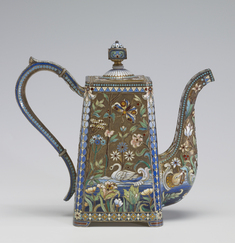Waste Bowl with Aquatic Decoration
(18th and 19th Centuries )
This waste bowl (used for discarding waste tea and tea leaves) is decorated with bird and aquatic motifs in raised, painted filigree enamel over a plain gilt ground. The enamels' predominating colors include various shades of blue, white with tinges of pink and yellow, and green. Small circles in red or gold foil provide extra highlights. The bowl comes from a tea and coffee service set, and, despite the consistency in the decoration, the teapot, coffee pot, and waste bowl differ from the other pieces in that they have variations in their blue and white borders. On the vessels' lower portions, eddies of water are indicated by curving lines of filigree. Among the motifs on the teapot are a swan, a heron, swallows, carp, a hawk, and water lilies. The coffee pot shows swans, storks, a butterfly, and comical carp-like fish, which raises its head above the water surface. A pheasant, stork, rising sun, and various blossoms and reeds appear on the creamer, whereas the most noticeable creatures on the sugar bowl are an owl, a frog, and a stork in flight.
Inscription
Provenance
Provenance (from the French provenir, 'to come from/forth') is the chronology of the ownership, custody, or location of a historical object. Learn more about provenance at the Walters.
Christies, New York; Jean M. Riddell, Washington, D.C., June 15, 1982, by purchase; Walters Art Museum, 2010, by bequest.
Geographies
Russia, Moscow (Place of Origin)
Measurements
H: 2 1/8 x W: 4 15/16 x D: 4 13/16 in. (5.4 x 12.6 x 12.3 cm)
Credit Line
Bequest of Mrs. Jean M. Riddell, 2010
Location in Museum
Not on view
Accession Number
In libraries, galleries, museums, and archives, an accession number is a unique identifier assigned to each object in the collection.
In libraries, galleries, museums, and archives, an accession number is a unique identifier assigned to each object in the collection.
44.754



